Modeling Mine Workforce Fatigue: Finding Leading Indicators of Fatigue in Operational Data Sets
Abstract
1. Introduction
2. Literature Review
3. Methodology
3.1. Data Set Characterization
Data Pre-Processing
3.2. Initial Data Analysis
3.3. Machine Learning Model
- Data collection;
- Data pre-processing;
- Data engineering;
- Training model;
- Testing model;
- Model evaluation;
- Making predictions.
3.3.1. Random Forest Regression Algorithm
3.3.2. Model
3.3.3. Evaluating Model Performance
3.3.4. Model Generalization
3.3.5. Feature Importance
4. Results
4.1. Feature Importance of Best-Performing Model
4.2. Drop-Column Feature Importance
4.3. ICE Plot
4.4. Comparison
5. Discussion
6. Limitations and Future Work
- Looking at individual fatigue events instead of the aggregated fatigue events;
- Using a machine learning method that can model more complex relationships, such as a neural network;
- Increasing the size of the training data set—this could be accomplished by adding more data either from the same mine or from another mine;
- Creating common naming conventions between data sets so that they can be linked by location, operator and equipment;
- Adding more complex features such as the sleep pattern, health condition, fitness or diet of the operator;
- Adding features that represent information collected during time periods prior to when the fatigue occurred, such as downtime or production on the previous day;
- Adding some features related to the working schedule of the operator in terms of fatigue at the time and the day or week before;
- Exploring more details of each feature to reduce the number of features that have a lower impact on fatigue.
Author Contributions
Funding
Data Availability Statement
Acknowledgments
Conflicts of Interest
Appendix A

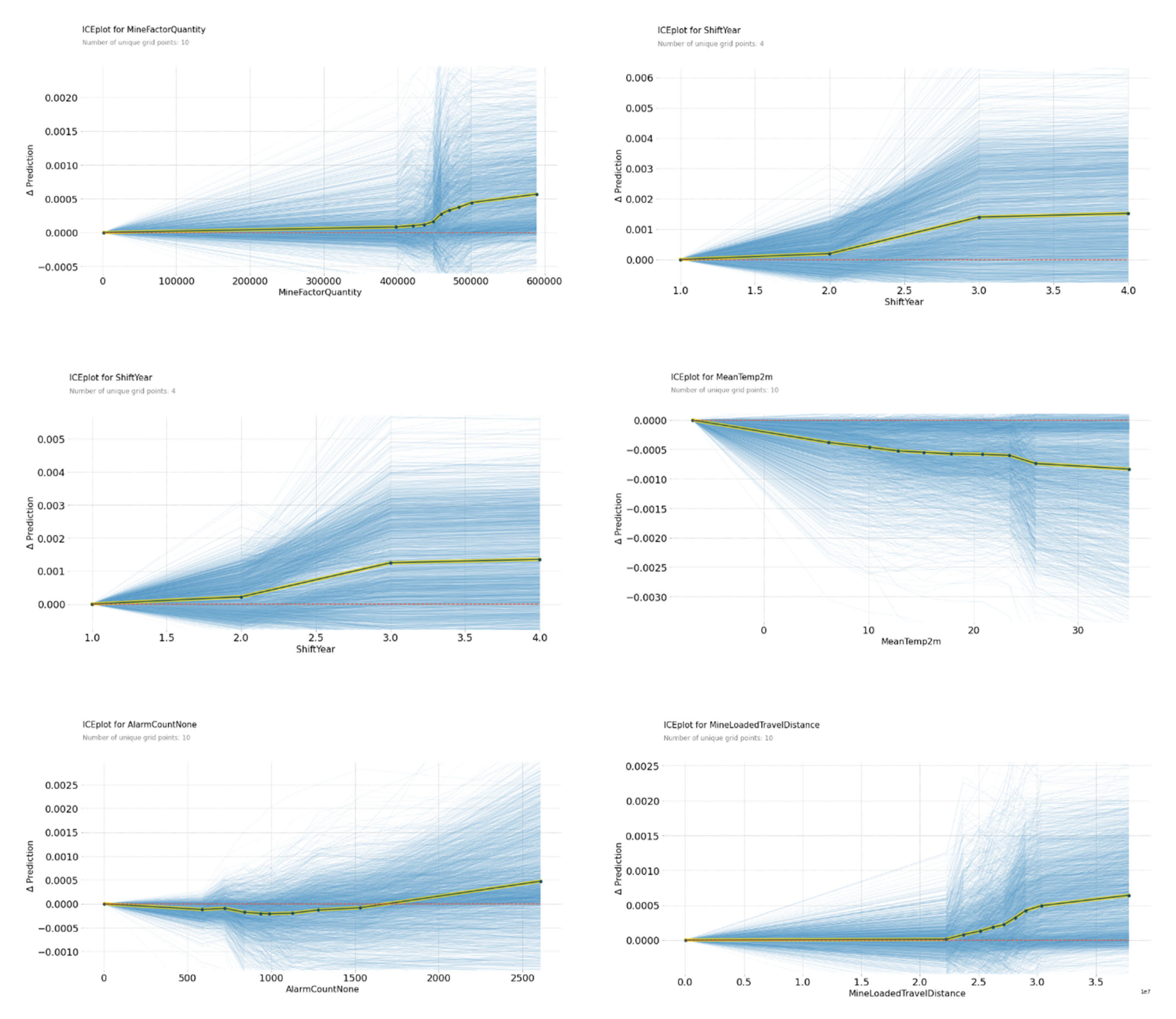
References
- Bauerle, T.; Dugdale, Z.; Poplin, G. Mineworker fatigue: A review of what we know and future directions. Min. Eng. 2018, 70, 1–19. [Google Scholar]
- Drews, F.A.; Rogers, W.P.; Talebi, E.; Lee, S. The Experience and Management of Fatigue: A Study of Mine Haulage Operators. Min. Metall. Explor. 2020, 37, 1837–1846. [Google Scholar] [CrossRef]
- Dawson, D.; Searle, A.K.; Paterson, J.L. Look before you (s)leep: Evaluating the use of fatigue detection technologies within a fatigue risk management system for the road transport industry. Sleep Med. Rev. 2014, 18, 141–152. [Google Scholar] [CrossRef] [PubMed]
- Briggs, C.; Nolan, J.; Heiler, K. Fitness for Duty in the Australian Mining Industry: Emerging Legal and Industrial Issues; 186487421X; Australian Centre for Industrial Relations Research and Teaching: Sydney, NSW, Australia, 2001; pp. 1–52. [Google Scholar]
- Parker, T.W.; Warringham, C. Fitness for work in mining: Not a ‘one size fits all’ approach. In Proceedings of the Queensland Mining Industry Health & Safety Conference, Brookfield, QLD, Australia, 4–7 August 2004. [Google Scholar]
- Hutchinson, B. “Fatigue Management in Mining—Time to Wake up and Act”, Optimize Consulting. 2014. Available online: http://www.tmsconsulting.com.au/basic-fatigue-management-in-mining/ (accessed on 25 January 2020).
- Pelders, J.; Nelson, G. Contributors to Fatigue of Mine Workers in the South African Gold and Platinum Sector. Saf. Health Work 2019, 10, 188–195. [Google Scholar] [CrossRef]
- Cavuoto, L.; Megahed, F. Understanding fatigue and the implications for worker safety. In Proceedings of the ASSE Professional Development Conference and Exposition, Atlanta, GA, USA, 26 June 2016. [Google Scholar]
- Talebi, E.; Roghanchi, P.; Abbasi, B. Heat management in mining industry: Personal risk factors, mitigation practices, and industry actions. In Proceedings of the 17th North American Mine Ventilation Symposium, Montreal, QC, Canada, 28 April–1 May 2019. [Google Scholar]
- Talebi, E.; Sunkpal, M.; Sharizadeh, T.; Roghanchi, P. The Effects of Clothing Insulation and Acclimation on the Thermal Comfort of Underground Mine Workers. Min. Metall. Explor. 2020, 37, 1827–1836. [Google Scholar] [CrossRef]
- Yung, M. Fatigue at the Workplace: Measurement and Temporal Development. Ph.D. Thesis, University of Waterloo, Waterloo, ON, Canada, 2016. [Google Scholar]
- Tufano, P. Who manages risk? An empirical examination of risk management practices in the gold mining company. J. Financ. 1996, 51, 1097–1137. [Google Scholar] [CrossRef]
- Wegerich, S.W.; Wolosewicz, A.; Xu, X.; Herzog, J.P.; Pipke, R.M. Automated Model Configuration and Deployment System for Equipment Health Monitoring. U.S. Patent No. 7,640,145 B2, 29 December 2009. [Google Scholar]
- Hinze, J.; Thurman, S.; Wehle, A. Leading indicators of construction safety performance. Saf. Sci. 2013, 51, 23–28. [Google Scholar] [CrossRef]
- Poh, C.Q.X.; Ubeynarayana, C.U.; Goh, Y.M. Safety leading indicators for construction sites: A machine learning approach. Autom. Constr. 2018, 93, 375–386. [Google Scholar] [CrossRef]
- Hallowell, M.R.; Hinze, J.W.; Baud, K.C.; Wehle, A. Proactive construction safety control: Measuring, monitoring, and responding to safety leading indicators. J. Constr. Eng. Manag. 2013, 139, 1–8. [Google Scholar] [CrossRef]
- Guo, B.H.W.; Yiu, T.W. Developing Leading Indicators to Monitor the Safety Conditions of Construction Projects. J. Manag. Eng. 2016, 32, 1–14. [Google Scholar] [CrossRef]
- Toellner, J. Improving Safety & Health Performance: Identifying & Measuring Leading Indicators. Prof. Saf. J. 2011, 46, 42–47. [Google Scholar]
- Grabowski, M.; Ayyalasomayajula, P.; Merrick, J.; McCafferty, D. Accident precursors and safety nets: Leading indicators of tanker operations safety. Marit. Policy Manag. 2007, 34, 405–425. [Google Scholar] [CrossRef]
- Hopkins, A. Thinking About Process Safety Indicators. In Proceedings of the Oil and Gas Industry Conference, Manchester, UK, 4–6 November 2007. [Google Scholar]
- Hale, A. Why safety performance indicators? Saf. Sci. 2009, 47, 479–480. [Google Scholar] [CrossRef]
- Costin, A.; Wehle, A.; Adibfar, A. Leading indicators—a conceptual IoT-based framework to produce active leading indicators for construction safety. Safety 2019, 5, 86. [Google Scholar] [CrossRef]
- Kononenko, I.; Kukar, M. Machine Learning and Data Mining; Woodhead Publishing: Cambridge, UK, 2007; pp. 1–36. [Google Scholar]
- Thibaud, M.; Chi, H.; Zhou, W.; Piramuthu, S. Internet of Things (IoT) in high-risk Environment, Health and Safety (EHS) industries: A comprehensive review. Decis. Support Syst. 2018, 108, 79–95. [Google Scholar] [CrossRef]
- Molaei, F.; Rahimi, E.; Siavoshi, H.; Afrouz, S.G.; Tenorio, V. A Comprehensive Review on Internet of Things (IoT) and its Implications in the Mining Industry. Am. J. Eng. Appl. Sci. 2020, 13, 499–515. [Google Scholar] [CrossRef]
- Shahmoradi, J.; Talebi, E.; Roghanchi, P.; Hassanalian, M. A comprehensive review of applications of drone technology in the mining industry. Drones 2020, 4, 34. [Google Scholar] [CrossRef]
- Tixier, A.J.P.; Hallowell, M.R.; Rajagopalan, B.; Bowman, D. Application of machine learning to construction injury prediction. Autom. Constr. 2016, 69, 102–114. [Google Scholar] [CrossRef]
- Lingard, H.; Hallowell, M.; Salas, R.; Pirzadeh, P. Leading or lagging? Temporal analysis of safety indicators on a large infrastructure construction project. Saf. Sci. 2017, 91, 206–220. [Google Scholar] [CrossRef]
- Cheng, T. When Artificial Intelligence Meets the Construction Industry. Available online: https://www.gxcontractor.com/equipment/article/13031944/when-artificial-intelligence-meets-the-construction-industry (accessed on 25 May 2018).
- Liaw, A.; Wiener, M. Classification and regression by random Forest. R News 2002, 2, 18–22. [Google Scholar]
- Breiman, L. Random Forests. Mach. Learn. 2001, 45, 5–32. [Google Scholar] [CrossRef]
- Segal, M.R. Machine Learning Benchmarks and Random Forest Regression; Technical Report for Center for Bioinformatics and Molecular Biostatistics; University of California: San Francisco, CA, USA, April 2003. [Google Scholar]
- Heaton, J.; McElwee, S.; Fraley, J.; Cannady, J. Early stabilizing feature importance for TensorFlow deep neural networks. In Proceedings of the 2017 International Joint Conference on Neural Networks (IJCNN), Anchorage, AK, USA, 14–19 May 2017; pp. 4618–4624. [Google Scholar]
- Menze, B.H.; Kelm, B.M.; Masuch, R.; Himmelreich, U.; Bachert, P.; Petrich, W.; Hamprecht, F.A. A comparison of random forest and its Gini importance with standard chemometric methods for the feature selection and classification of spectral data. BMC Bioinform. 2009, 10, 213. [Google Scholar] [CrossRef]
- Molnar, C. Interpretable Machine Learning, A Guide for Making Black Box Models Explainable. Available online: https://christophm.github.io/interpretable-ml-book/ (accessed on 25 March 2021).
- Minitab Blog Editor. Regression Analysis: How Do I Interpret R-Squared and Assess the Goodness-of-Fit? Available online: https://blog.minitab.com/en/adventures-in-statistics-2/regression-analysis-how-do-i-interpret-r-squared-and-assess-the-goodness-of-fit (accessed on 20 February 2021).
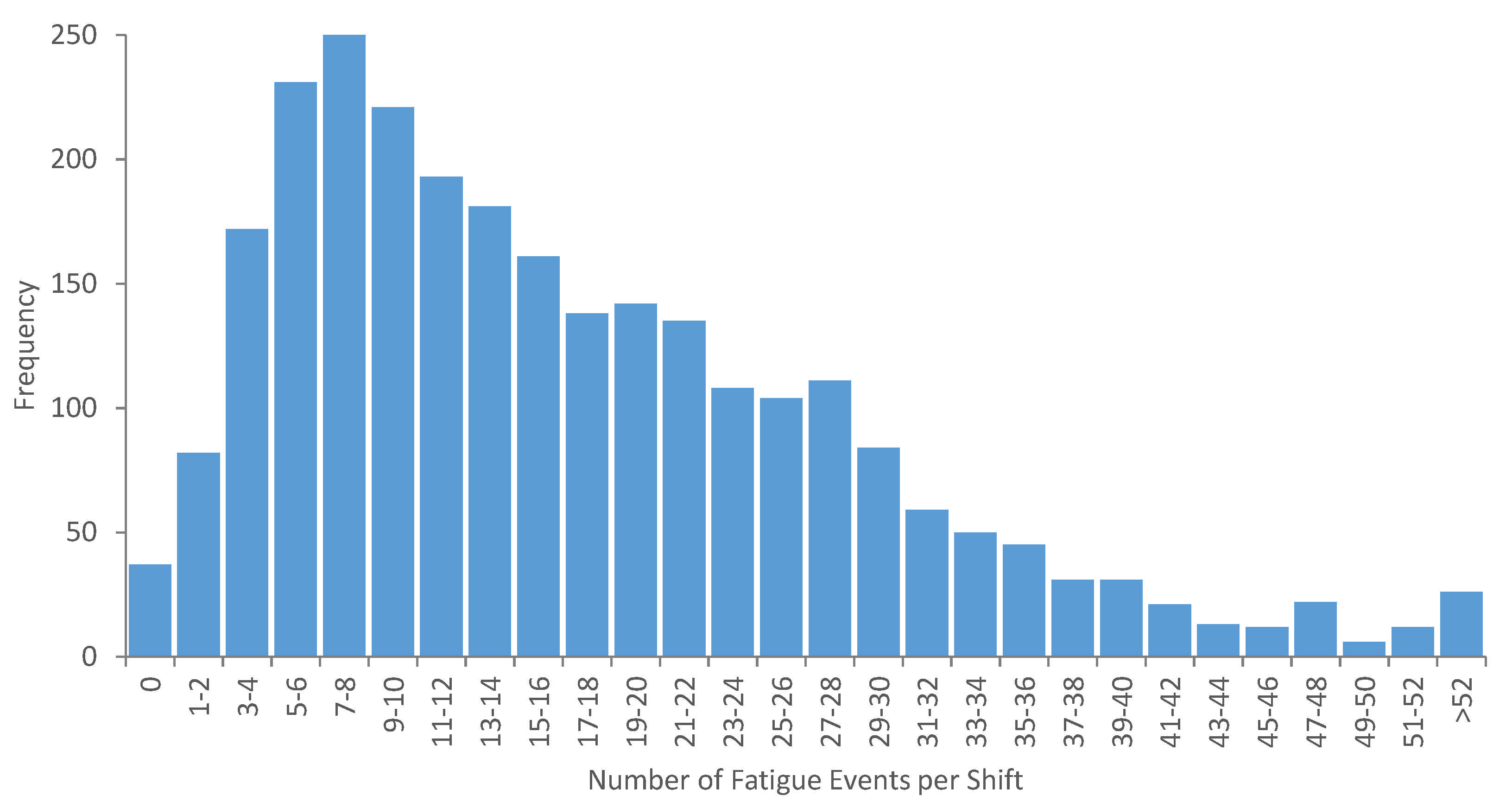

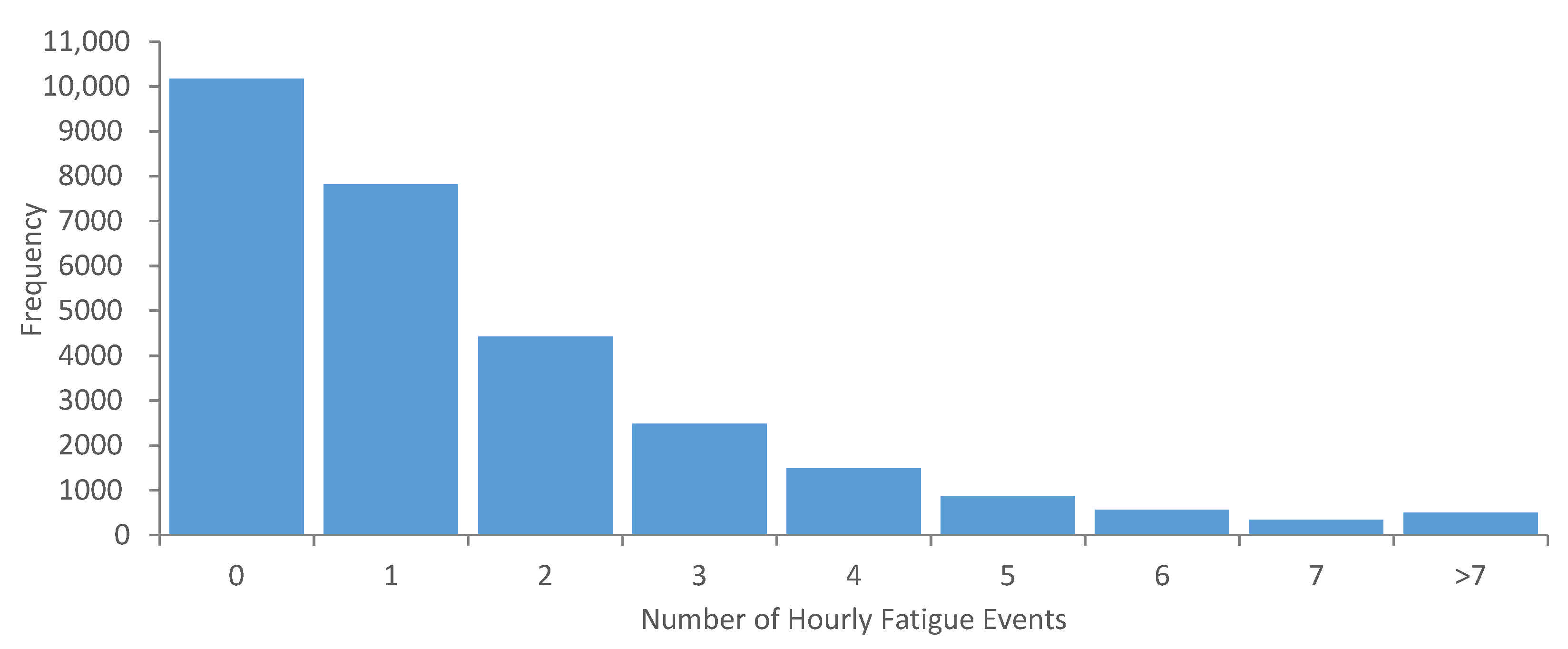



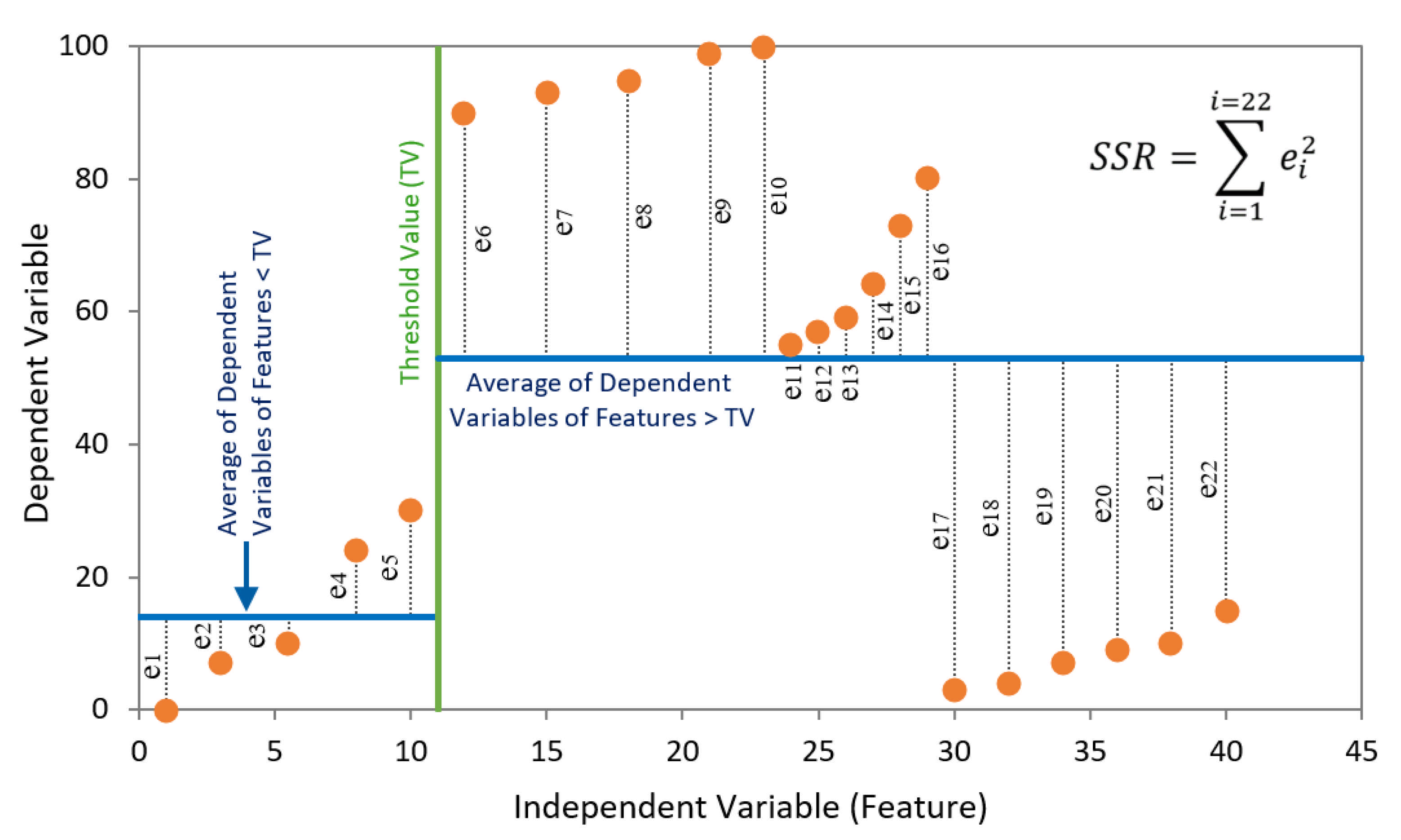
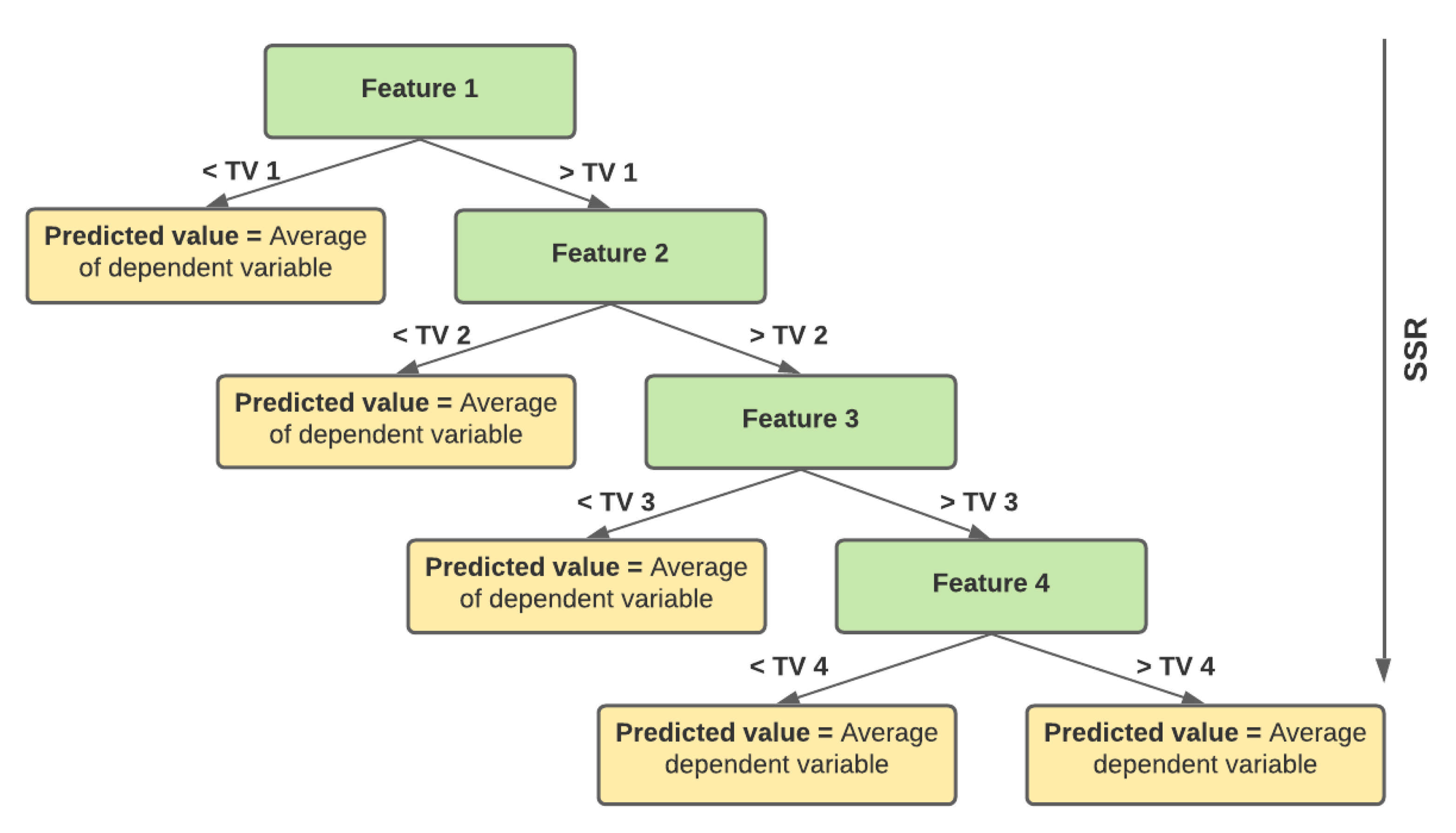

| Data Source | Key Factors | Date Range |
|---|---|---|
| Fatigue monitoring | Operator drowsiness, micro-sleeps, etc. | 2014–2017 |
| Time and Attendance | Hours worked, shift worked, etc. | 2014–2017 |
| Fleet management system (production and status) | Production cycles, faulty equipment, delayed equipment, etc. | 2014–2017 |
| Equipment health alarms and events | Notification of equipment abuse, use of equipment, etc. | 2014–2017 |
| Weather conditions | Temperature, wind speed, wind direction, change, precipitation, relative humidity, etc. | 2014–2017 |
| Fatigue Event Type | Average Number of Events per Day | Days with Fatigue Events | Percentage of Days with Fatigue | Percentage of Fatigue Events |
|---|---|---|---|---|
| Micro-Sleep with Stable Head | 13 | 1313 | 98% | 40% |
| Other Eye Closure (Drowsiness) | 20 | 1327 | 99% | 60% |
| Data Source | Variables | Data Type and Example Data |
|---|---|---|
| Time and Attendance | Shift ID | Integer (1 to 4140) |
| Shift of Day (shift type) | Categorical Integer (0 and 1) | |
| Crew Name | Categorical Integer (1 to 4) | |
| Days On | Integer (0 to 4) | |
| Year | Integer (2014 to 2017) | |
| Month | Integer (1 to 12) | |
| Week | Integer (1 to 54) | |
| Day | Integer (1 to 31) | |
| Day of week | Integer (1 to 7) | |
| Day of year | Integer (1 to 365) | |
| Hour of day | Float (0 to 24) | |
| Shift is end of month | Categorical Integer (0 and 1) | |
| Shift is start of month | Categorical Integer (0 and 1) | |
| Shift is end of quarter | Categorical Integer (0 and 1) | |
| Shift is start of quarter | Categorical Integer (0 and 1) | |
| Shift is end of year | Categorical Integer (0 and 1) | |
| Shift is start of year | Categorical Integer (0 and 1) | |
| Fleet management system (production and status) | Mine Production Factor | Integer (1335 to 589,201) |
| Mine Loaded Travel Distance | Integer (37,884 to 37,797,788) | |
| Mine Measured Production | Integer (0 to 430,812) | |
| Mean Measured Production (broken down by fleet, creating 8 variables) | Float (0 to 413.83) | |
| Mine Load Capacity Percentage | Float (0 to 1) | |
| Mean Load Capacity Percentage (broken down by fleet, creating 8 variables) | Float (0 to 1) | |
| Mean Loaded Travel Distance | Float (3735.2 to 13,711.66) | |
| Mean Loaded Travel Lift | Float (272.25 to 1083.29) | |
| Mean Loaded Travel Lift Distance | Float (3735.2 to 13,711.66) | |
| St Dev Loaded Travel Distance | Float (604.55 to 16,118.27) | |
| Weather | Mean Barometric Pressure | Float (0 to 25.1) |
| Mean Precipitation | Float (0 to 439.1) | |
| Mean Temperature (2 m) | Float (−6.8 to 34.8) | |
| Min Barometric Pressure | Float (0 to 25.01) | |
| Min Precipitation | Float (0 to 29.71) | |
| Min Temperature (2 m) | Float (−8.4 to 30.44) | |
| Max Barometric Pressure | Float (0 to 25.1) | |
| Max Precipitation | Float (0 to 756.9) | |
| Max Temperature (2 m) | Float (−4.435 to 36.82) | |
| Sum Precipitation | Float (0 to 5269.17) | |
| Equipment health alarms and events | Both Alarm Count | Integer (0 to 632) |
| Electrical Alarm Count | Integer (0 to 892) | |
| Lockout Alarm Count | Integer (0 to 35) | |
| Maintenance Alarm Count | Integer (0 to 1094) | |
| Mechanical Alarm Count | Integer (0 to 1753) | |
| None Alarm Count | Integer (0 to 2608) | |
| Normal Alarm Count | Integer (0 to 121) | |
| Operational Alarm Count | Integer (0 to 819) | |
| Undetermined Alarm Count | Integer (0 to 1282) | |
| Scheduled Down Count | Integer (0 to 85) | |
| Unscheduled Down Count | Integer (0 to 141) | |
| Operational Delay Count | Integer (0 to 1126) | |
| Operational Down Count | Integer (0 to 80) | |
| Ready Non-Production Count | Integer (0 to 977) | |
| Ready Production Count | Integer (0 to 1322) | |
| Fatigue monitoring system | Drowsiness and Micro-Sleep Fatigue Events Count (Normalized) | Float (0 to 1) |
| Model | Root Mean Squared Error (RMSE) | Coefficient of Determination R2 | |||
|---|---|---|---|---|---|
| Training | Validation | Training | Validation | OOB | |
| Shift-based model | 0.002 | 0.006 | 0.93 | 0.36 | 0.47 |
| Data Category | Dependent Variables | Feature Importance Score |
|---|---|---|
| Time and Attendance | Shift type (day or night shift) | 0.1650 |
| Equipment health alarms and events | Unscheduled downtime count | 0.0588 |
| Fleet management system (production and status) | Mine load capacity percentage | 0.0297 |
| Mine measured production | 0.0293 | |
| Mine production factor | 0.0248 | |
| Time and Attendance | Year | 0.0245 |
| Weather | Mean temperature (2 m) | 0.0235 |
| Equipment health alarms and events | None alarm count | 0.0230 |
| Fleet management system (production and status) | Mine loaded travel distance | 0.0226 |
| Mean measured production of haul truck (CAT 793D) | 0.0226 | |
| Weather | Maximum temperature (2 m) | 0.0223 |
| Equipment health alarms and events | Ready production count | 0.0222 |
| Mechanical alarm count | 0.0215 | |
| Fleet management system (production and status) | Mean load capacity percentage of haul truck (CAT 793D) | 0.0213 |
| Mean measured production of haul truck (CAT 793C) | 0.0211 | |
| Mean loaded travel distance | 0.0209 | |
| Mean measured production of haul truck (CAT 793B) | 0.0209 | |
| Mean load capacity percentage of haul truck (CAT 793C) | 0.0208 | |
| Mean load capacity percentage of haul truck (CAT 793B) | 0.0207 | |
| Equipment health alarms and events | Scheduled down count | 0.0206 |
| Dependent Variables | Feature Importance Score |
|---|---|
| Shift type (day or night) | 0.2922 |
| Unscheduled downtime count | 0.0317 |
| Mechanical alarm count | 0.0235 |
| Day on | 0.0225 |
| Day of week | 0.0205 |
| Mean measured production of haul truck (CAT 797F) | 0.0139 |
| Shift is end of year | 0.0129 |
| Electrical alarm count | 0.0129 |
| Mine measured production | 0.0127 |
| Undetermined alarm count | 0.0125 |
| … | … |
| None alarm count | −0.0022 |
| Mean loaded travel distance | −0.0025 |
| Mean load capacity percentage of haul truck (CAT 793D) | −0.0031 |
| Year | −0.0034 |
| Mean Temperature (2 m) | −0.0073 |
| Mean load capacity percentage of haul truck (CAT 793B) | −0.0073 |
| Mean loaded travel lift distance | −0.0074 |
| Maintenance alarm count | −0.0083 |
| Mean loaded travel lift | −0.0119 |
| Mine load capacity percentage | −0.0325 |
| Rankings | Shift-Based Model | Hourly-Based Model |
|---|---|---|
| 1 | Shift type (day or night shift) | Mean temperature (2 m) |
| 2 | Unscheduled downtime count | Hour of day |
| 3 | Mine load capacity percentage | Mean measured production of haul truck (CAT 793B) |
| 4 | Mine measured production | Mean measured production of haul truck (CAT 793D) |
| 5 | Mine production factor | None alarm count |
| 6 | Year | St Dev loaded travel distance |
| 7 | Mean temperature (2 m) | Mean barometric pressure |
| 8 | None alarm count | Maintenance alarm count |
| 9 | Mine loaded travel distance | Undetermined alarm count |
| 10 | Mean measured production of haul truck (CAT 793D) | Mine production factor |
| Data Category | Feature Rank | Feature |
|---|---|---|
| Time and attendance | 1 | Shift of day (day or night) |
| 6 | Year | |
| Fleet management system (production and status) | 3 | Mine load capacity percentage |
| 4 | Mine measured production | |
| 5 | Mine production factor | |
| 9 | Mine loaded travel distance | |
| 10 | Mean measured production of haul truck (CAT 793D) | |
| 14 | Mean load capacity percentage of haul truck (CAT 793D) | |
| 15 | Mean measured production of haul truck (CAT 793C) | |
| 16 | Mean loaded travel distance | |
| 17 | Mean measured production of haul truck (CAT 793B) | |
| 18 | Mean load capacity percentage of haul truck (CAT 793C) | |
| 19 | Mean load capacity percentage of haul truck (CAT 793B) | |
| Equipment health alarms and events | 2 | Unscheduled down count |
| 8 | None alarm count | |
| 12 | Ready production count | |
| 13 | Mechanical alarm count | |
| 20 | Scheduled downtime count | |
| Weather | 7 | Mean temperature (2 m) |
| 11 | Maximum temperature (2 m) |
Publisher’s Note: MDPI stays neutral with regard to jurisdictional claims in published maps and institutional affiliations. |
© 2021 by the authors. Licensee MDPI, Basel, Switzerland. This article is an open access article distributed under the terms and conditions of the Creative Commons Attribution (CC BY) license (https://creativecommons.org/licenses/by/4.0/).
Share and Cite
Talebi, E.; Rogers, W.P.; Morgan, T.; Drews, F.A. Modeling Mine Workforce Fatigue: Finding Leading Indicators of Fatigue in Operational Data Sets. Minerals 2021, 11, 621. https://doi.org/10.3390/min11060621
Talebi E, Rogers WP, Morgan T, Drews FA. Modeling Mine Workforce Fatigue: Finding Leading Indicators of Fatigue in Operational Data Sets. Minerals. 2021; 11(6):621. https://doi.org/10.3390/min11060621
Chicago/Turabian StyleTalebi, Elaheh, W. Pratt Rogers, Tyler Morgan, and Frank A. Drews. 2021. "Modeling Mine Workforce Fatigue: Finding Leading Indicators of Fatigue in Operational Data Sets" Minerals 11, no. 6: 621. https://doi.org/10.3390/min11060621
APA StyleTalebi, E., Rogers, W. P., Morgan, T., & Drews, F. A. (2021). Modeling Mine Workforce Fatigue: Finding Leading Indicators of Fatigue in Operational Data Sets. Minerals, 11(6), 621. https://doi.org/10.3390/min11060621






